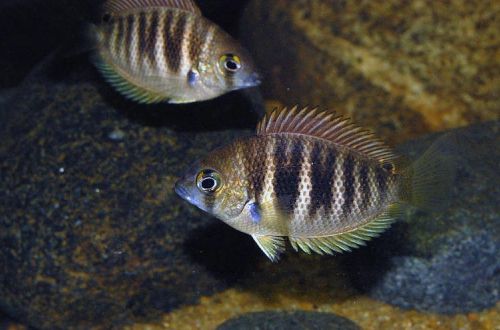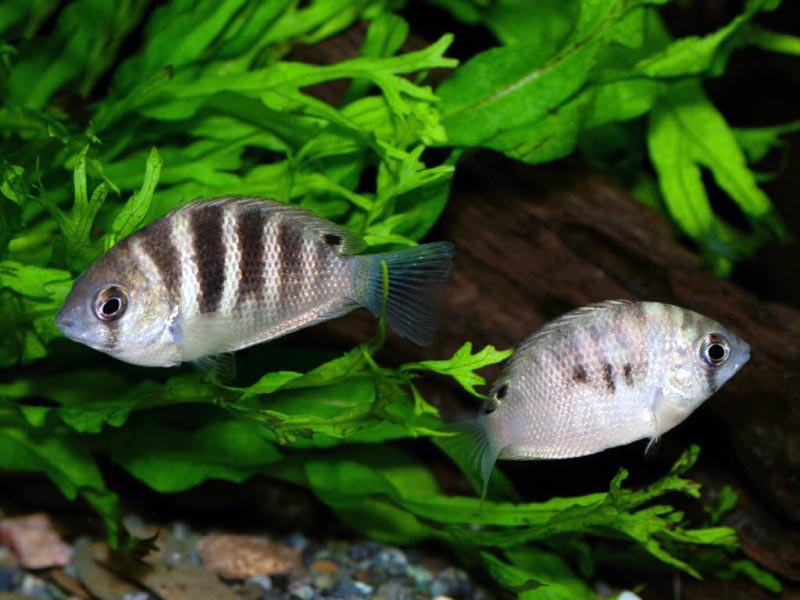
Etroplus Canara
Etroplus Canara, scientific name Etroplus canarensis, belongs to the Cichlidae family. The fish is named after the region where it was discovered – the area of South Canara in the state of Karnataka, India. Representative of a rare and small group of Asian cichlids. Widely available in the aquarium hobby due to mass breeding on fish farms in Southeast Asia.
It is considered easy to keep, unpretentious and able to get along with many other popular fish. May be recommended for beginner aquarists.

Contents
Habitat
It comes from Asia from a limited region in the Indian state of Karnataka in the southwest of the country. Inhabits the basin of the Netravati River and its main tributary Kumaradhara. The natural habitat is subject to seasonal changes associated with the annual monsoons. The fish can live both in clear clear waters with a slow current, and in turbid conditions with a variable speed of water flow.
In nature, next to the Etroplus Canara, there are other popular fish in the aquarium trade, such as Barbus Maheola, Malabar Danio, Indian glass perch, Striped Rasbora and many others.
Brief information:
- The volume of the aquarium – from 250 liters.
- Temperature – 22-32°C
- Value pH — 6.0–7.5
- Water hardness – 1–10 dGH
- Substrate type – gravel, sand
- Lighting – subdued
- Brackish water – no
- Water movement – weak, moderate
- The size of the fish is 10–11 cm.
- Food – any food
- Temperament – peaceful
- Content in a group of at least 8 individuals
Description

Adult individuals reach a length of 10–11 cm. The shape of the body resembles a disk or oval – high and laterally compressed. The coloration is gray-brown with rows of vertical dark strokes. Sexual dimorphism is weakly expressed, outwardly males and females are practically indistinguishable.
Food
Undemanding to the composition of food, in the home aquarium they will accept most foods intended for aquarium fish. The daily diet may look like this – dry flakes, granules in combination with live or frozen brine shrimp, daphnia, bloodworms, etc.
Maintenance and care, arrangement of the aquarium
The optimal size of an aquarium for a flock of 8-10 fish starts at 250 liters. The design should resemble a natural habitat – a riverbed with a gravel-sand substrate mixed with several large boulders and numerous snags. Aquatic plants are optional, if desired, you can plant unpretentious species from among Anubias or mosses, ferns, for example, Microsorum pterygoid, Malayan water fern and others.
Etroplus Canara needs clean, oxygen-rich, slightly acidic water with low carbonate hardness. It is important to ensure stable water conditions without sudden changes in temperature and hydrochemical parameters, as well as to monitor the concentrations of nitrogen cycle products. To do this, the aquarium must be equipped with the necessary equipment (filter, aerator, heater, etc.), as well as regular maintenance procedures. At a minimum, it is necessary to carry out a weekly replacement of part of the water (30–50% of the volume) with fresh water, remove organic waste (feed residues, excrement), carry out preventive maintenance of equipment, etc.
Behavior and Compatibility
Peaceful calm fish, if it is in a flock of at least 8 individuals, with a smaller number, the weaker members of the group will be attacked by dominant individuals.
Calmly relate to other neighbors in the aquarium. Compatible with many non-aggressive freshwater fish species.
Breeding / breeding
In a favorable environment and subject to a number of conditions, breeding is quite possible. In nature, spawning occurs from December to January, when heavy monsoon rains fall, the water level in the rivers rises and there is an excess of nutrients. In an aquarium, similar changes can be recreated if the water is cooled a few degrees over a couple of days. The fish become sexually mature at two years of age. During the spawning period, they form temporary pairs, at which time the color changes, it becomes dark, stripes appear on the head.
Eggs, as a rule, are attached to some flat surface (stone, snag). The male and female protect the clutch until the fry appear. Then the offspring should be transferred to a separate tank with identical water conditions to protect them from possible eating by adult fish.
Fish diseases
The main cause of diseases lies in the conditions of detention, if they go beyond the permissible range, then immunity suppression inevitably occurs and the fish becomes susceptible to various infections that are inevitably present in the environment. If the first suspicions arise that the fish is sick, the first step is to check the water parameters and the presence of dangerous concentrations of nitrogen cycle products. Restoration of normal/suitable conditions often promotes healing. However, in some cases, medical treatment is indispensable. Read more about symptoms and treatments in the Aquarium Fish Diseases section.





